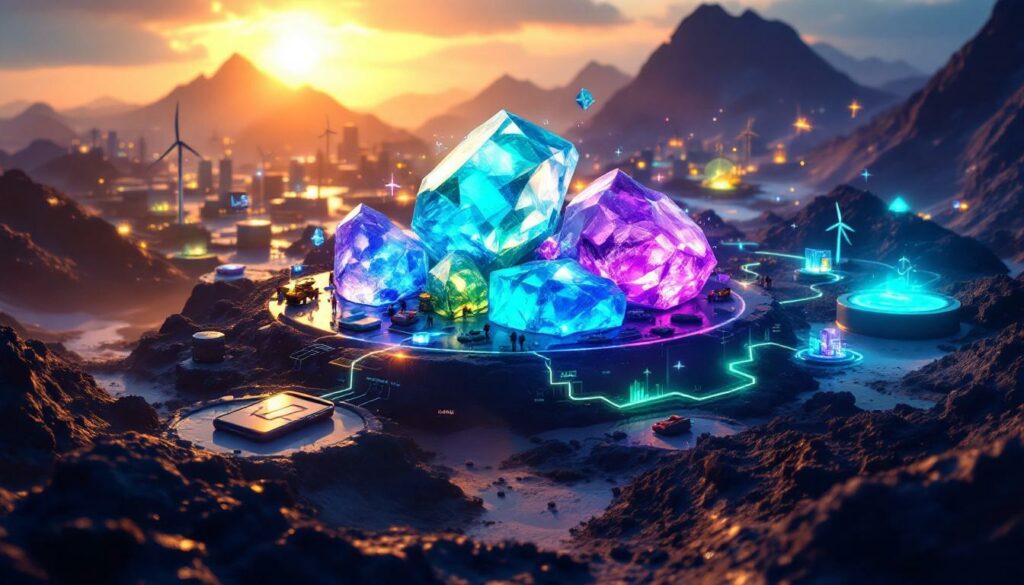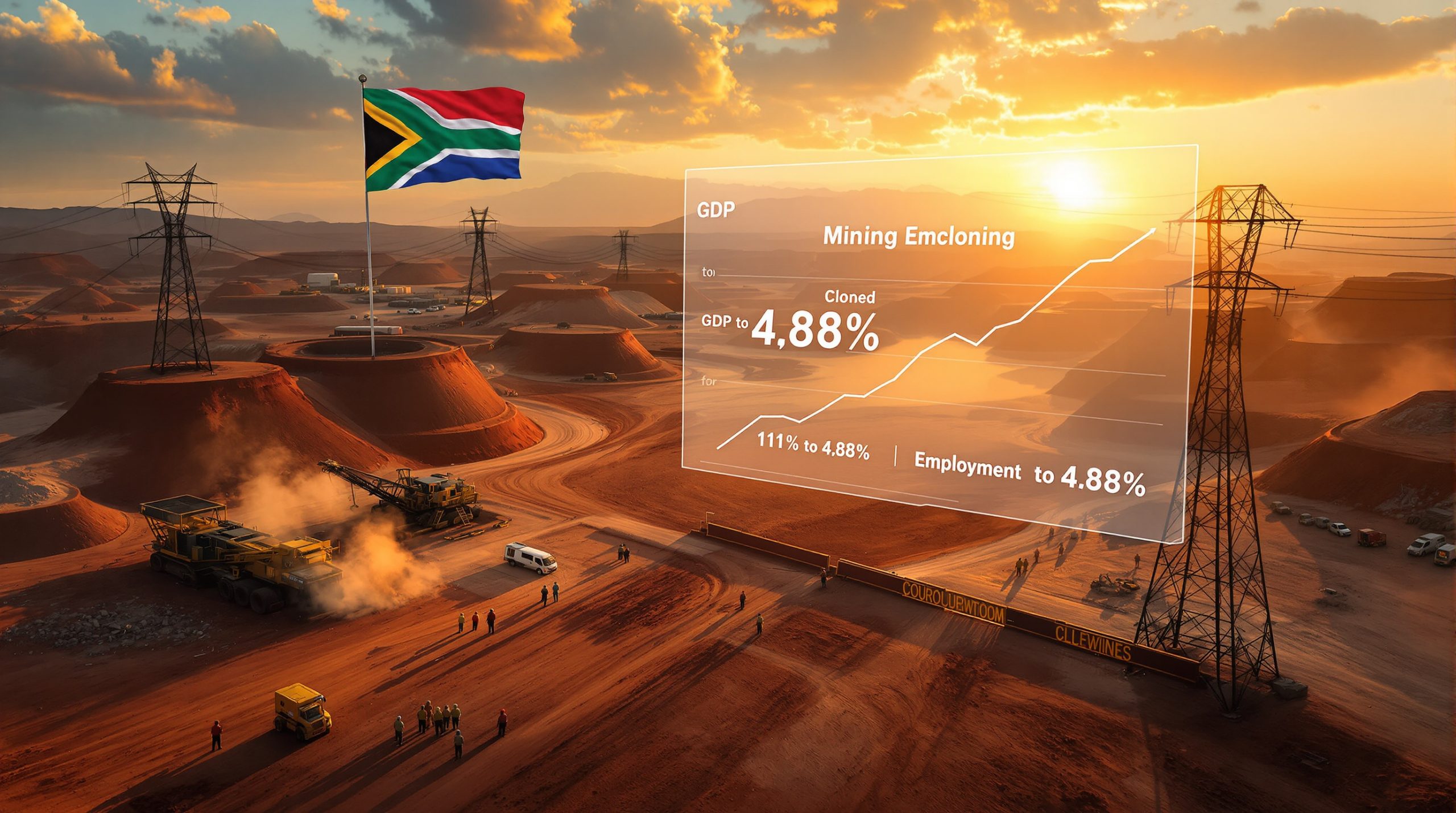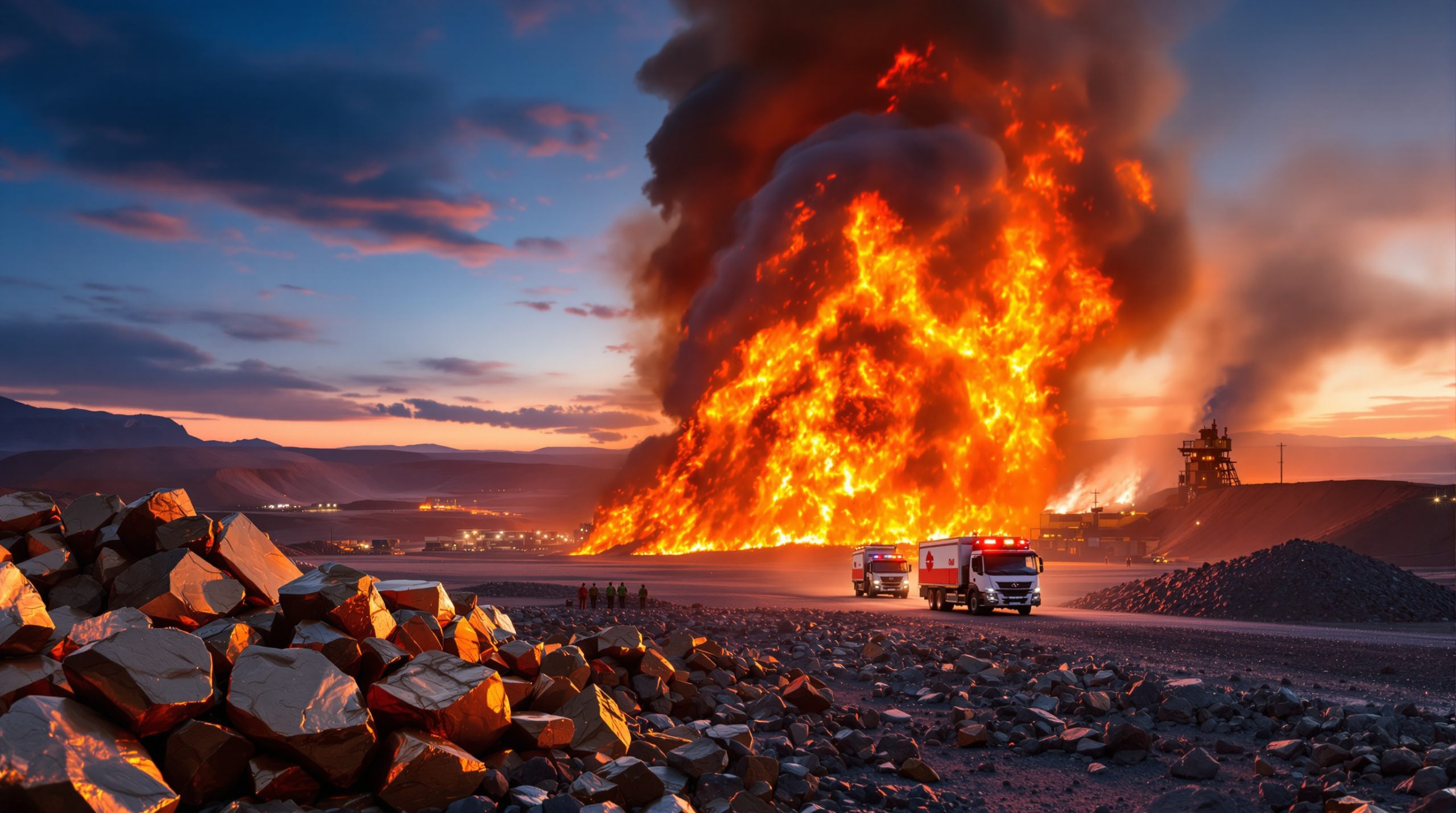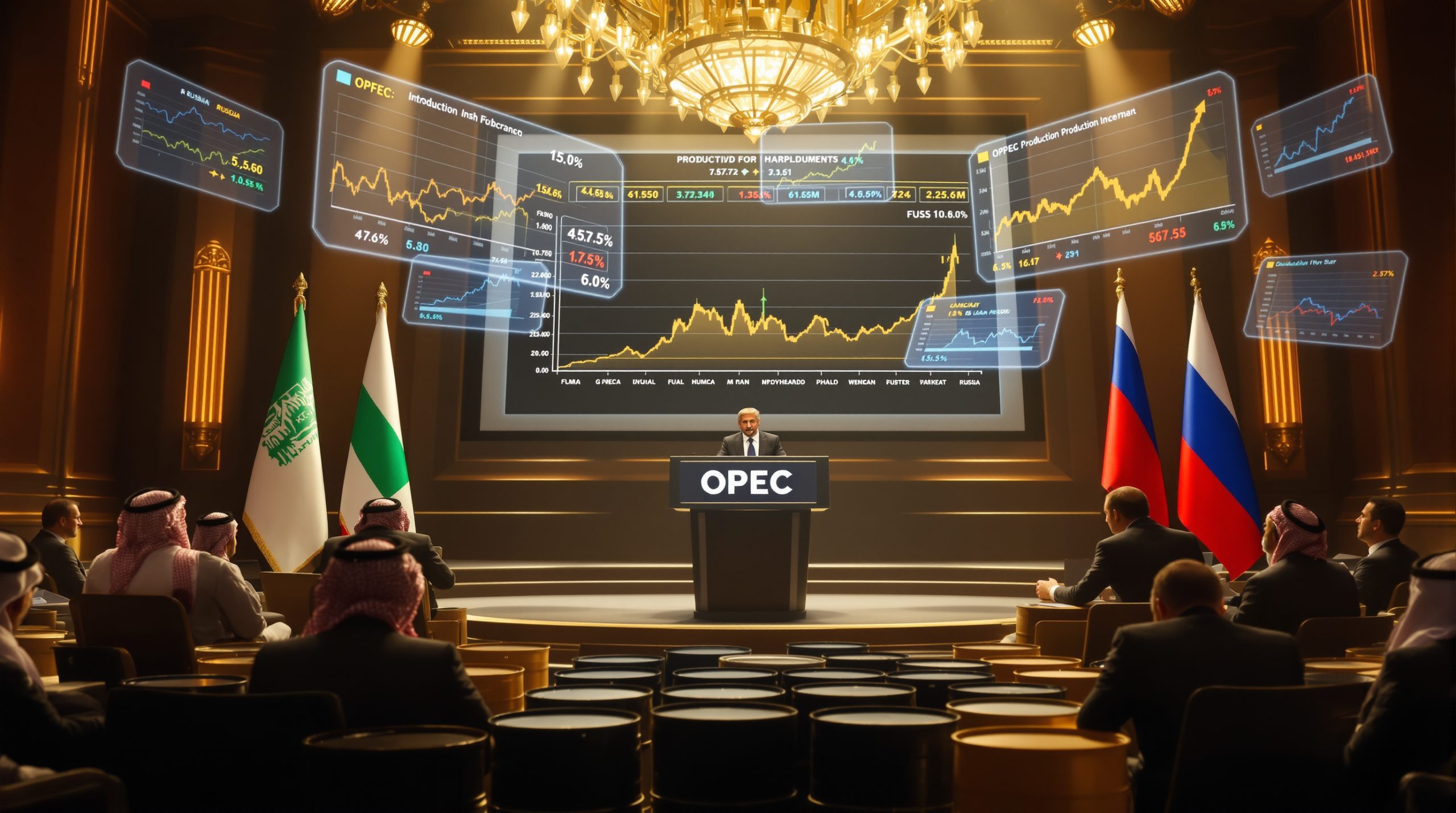Understanding Critical Minerals: The Foundation of Modern Technology
Critical minerals represent a category of natural resources that have become increasingly vital to global economies, national security, and technological advancement. Unlike common commodities, these minerals possess unique properties that make them indispensable in various high-tech applications while facing potential supply chain vulnerabilities.
The global critical minerals market was valued at approximately US$320 billion in 2024 and is projected to grow to US$480 billion by 2030, according to the International Energy Agency (IEA). This substantial growth highlights the increasing importance of what are critical minerals and how to invest in them in our modern economy.
As Jennifer Granholm, U.S. Secretary of Energy, noted, "Critical minerals are the building blocks for the clean energy technologies that will power our future. Securing reliable and sustainable supplies is a top priority for the United States."
What Defines a Mineral as "Critical"?
Critical minerals earn their designation based on four key factors that distinguish them from regular commodities:
- Essential for Modern Technologies: These minerals serve as fundamental components in technologies ranging from smartphones and computers to renewable energy systems and defense equipment
- Supply Chain Vulnerability: Production is often concentrated in a limited number of countries, creating geopolitical dependencies and risks
- Limited Substitution Options: Few or no viable alternatives exist that can deliver comparable performance at similar costs
- Strategic Importance: These minerals directly impact national security, economic prosperity, and technological sovereignty
The methodology for defining criticality typically involves assessing supply risk, environmental implications, and vulnerability to supply restrictions. Different countries have slightly different approaches, with the U.S. using a quantitative methodology based on economic vulnerability and supply risk.
The Geopolitical Dimension of Critical Minerals
The global distribution of critical minerals creates significant geopolitical implications:
- Concentration of Resources: Many critical minerals are predominantly sourced from a handful of countries, with China controlling substantial portions of processing capacity. The U.S. Geological Survey (USGS) reported in 2024 that China produces 60% of the world's rare earth elements and 70% of its graphite.
- National Security Concerns: Countries dependent on imports face potential vulnerabilities during geopolitical tensions or supply disruptions. A real-world example occurred in 2021 when a trade dispute between China and Japan led to a temporary halt in rare earth exports, causing global shortages.
- Strategic Competition: Major powers are increasingly viewing energy security & critical minerals as essential to maintaining technological leadership
The European Commission's Vice-President Maroš Šefčovič stated that the EU's critical minerals dependency is "a strategic vulnerability that requires immediate action." This sentiment is echoed across major economies globally.
Why Are Critical Minerals Essential in Today's Economy?
The importance of critical minerals extends across multiple sectors and applications, making them foundational to modern economies and technologies.
Powering the Green Energy Transition
Critical minerals play a central role in renewable energy technologies:
- Battery Storage Systems: Lithium, cobalt, nickel, and graphite form the backbone of energy storage solutions. According to the IEA, a typical electric car requires six times the mineral inputs of a conventional car.
- Solar Panels: Gallium, indium, selenium, and tellurium enable photovoltaic technology
- Wind Turbines: Rare earth elements like neodymium and dysprosium create powerful permanent magnets essential for efficient generators. An onshore wind plant requires nine times more minerals than a gas-fired power plant.
"Without critical minerals, there can be no energy transition. They are the foundation of the new energy economy," says Fatih Birol, Executive Director of the IEA. The World Bank suggests that the production of critical minerals could increase by 500% by 2050 to meet clean energy demand.
Enabling Digital Transformation
The digital economy relies heavily on critical minerals:
- Semiconductors and Electronics: Gallium, germanium, indium, and tantalum are essential components in chips and circuit boards
- Telecommunications Infrastructure: Rare earths and specialty metals support 5G networks and fiber optic systems
- Data Storage Technologies: Various critical minerals enable high-density storage solutions
Modern smartphones contain more than 30 different minerals, including small amounts of rare earths, tantalum, and cobalt—all classified as critical by major economies.
Supporting Defense and Aerospace Applications
Critical minerals are fundamental to national security:
- Advanced Weapons Systems: Specialty metals and rare earths are used in precision-guided munitions and radar systems
- Aircraft and Naval Vessels: Titanium, beryllium, and other critical minerals provide essential structural properties
- Satellite and Space Technologies: Various critical minerals enable communications, navigation, and surveillance capabilities
The U.S. Department of Defense uses approximately 750,000 tons of minerals annually, with critical minerals like beryllium and titanium being essential for aerospace applications.
Which Minerals Are Considered Critical?
While critical mineral lists vary by country based on specific economic and security needs, several categories consistently appear across national inventories. As of 2023, Australia lists 26 critical minerals, including lithium, cobalt, and rare earth elements.
Battery Metals: Powering the Electric Revolution
Battery metals form the foundation of energy storage technologies:
- Lithium: The lightest metal and crucial component in lithium-ion batteries, with applications ranging from electric vehicles to grid storage. Global lithium production reached 130,000 tons in 2024, with Australia being the largest producer (55% of global output).
- Cobalt: Provides stability and thermal resistance in battery cathodes, though efforts are underway to reduce dependence due to supply concerns. The Democratic Republic of Congo produces over 70% of global cobalt.
- Nickel: Increasingly important in high-energy-density batteries, with various grades serving different applications. Class 1 nickel (99.8% purity) is essential for EV batteries.
- Graphite: Forms the anode material in lithium-ion batteries, with natural and synthetic forms serving different market segments. China dominates graphite processing, handling about 70% of global production.
The cathode composition in lithium-ion batteries directly affects energy density and safety, making the selection of battery metals a critical engineering decision.
Rare Earth Elements (REEs): The Technology Metals
The 17 rare earth elements serve critical functions across high-tech applications:
- Light REEs: Including lanthanum, cerium, praseodymium, and neodymium, used in catalysts, glass polishing, and magnets
- Heavy REEs: Including dysprosium, terbium, and yttrium, critical for specialized applications in magnets, phosphors, and ceramics
- Magnet REEs: Neodymium, praseodymium, dysprosium, and terbium are particularly crucial for permanent magnets used in electric motors and wind turbines
Global reserves of rare earths are estimated at 130 million tons, with China holding 36% and Vietnam 18%. As James Kennedy, President of ThREE Consulting, explains: "Rare earth elements are not rare, but the ability to process them economically and responsibly is."
The process of separating individual rare earth elements is chemically complex and requires significant expertise. Solvent extraction is the most common method, highlighting the technical barriers to entry in this market.
Strategic Metals: Supporting Industrial and Defense Applications
Various other metals play critical roles in advanced applications:
- Titanium: Lightweight, strong, and corrosion-resistant, used in aerospace, medical implants, and chemical processing
- Vanadium: Enhances steel strength and serves in grid-scale flow batteries
- Tungsten: Extremely hard with a high melting point, essential for cutting tools and armor-piercing ammunition. China produces over 80% of global tungsten.
- Gallium and Germanium: Semiconductor materials crucial for electronics, LEDs, and solar cells. Both are primarily recovered as byproducts of aluminum and zinc production.
Nuclear and Energy Transition Minerals
Several minerals support nuclear energy and the broader energy transition:
- Uranium: The primary fuel for nuclear power plants, providing low-carbon baseload electricity. Kazakhstan is the top producer (43% of global supply), followed by Canada (13%) and Australia (12%).
- High-Purity Manganese: Used in battery cathodes for electric vehicles. High-purity manganese sulfate (HPMSM) contains >99.9% manganese and is essential for NMC (nickel-manganese-cobalt) batteries.
- Copper: Though more abundant than other critical minerals, its essential role in electrification makes it strategically important. The average EV contains about 80 kg of copper, compared to 20 kg in conventional vehicles.
The International Atomic Energy Agency (IAEA) notes that nuclear energy requires a secure supply of uranium, which is a critical mineral for low-carbon energy production.
How Can Investors Participate in the Critical Minerals Market?
The growing importance of what are critical minerals and how to invest in them creates various investment opportunities across the value chain.
Direct Investment in Mining Companies
Investors can gain exposure through companies involved in exploration, development, and production:
- Major Diversified Miners: Established companies with critical minerals divisions alongside traditional commodities. Examples include BHP Group (ASX:BHP), which has committed $5 billion to expand its nickel and copper production for battery materials.
- Pure-Play Producers: Companies focused exclusively on specific critical minerals. Pilbara Minerals (ASX:PLS) for lithium, Lynas Rare Earths (ASX:LYC) for rare earths, and Paladin Energy (ASX:PDN) for uranium are notable examples.
- Junior Explorers and Developers: Earlier-stage companies with potentially significant upside but higher risk profiles. These companies typically have market capitalizations under $100 million and are focused on exploration and early development.
"Investing in critical minerals requires a long-term view and understanding of the entire value chain," advises Rick Rule, Founder of Sprott Inc. A report by PwC highlights that investment in critical minerals mining projects increased by 30% year-on-year in 2024.
Critical Mineral ETFs and Funds
For diversified exposure to the sector:
- Specialty ETFs: Funds targeting specific segments like battery metals, rare earths, or uranium. The Global X Lithium & Battery Tech ETF (LIT) has over $2 billion in assets under management as of 2025.
- Thematic Funds: Broader investment vehicles focused on energy transition or technological materials. The VanEck Rare Earth/Strategic Metals ETF (REMX) provides exposure to companies involved in mining, refining, and recycling of rare earth and strategic metals.
- Commodity Funds: Some funds provide direct exposure to physical metals or futures contracts. These can offer more direct price exposure but often with higher carrying costs.
Downstream and Processing Investments
Beyond mining, opportunities exist in processing and manufacturing:
- Refining and Processing Companies: Firms that convert raw materials into usable forms. Companies like CATL (Contemporary Amperex Technology) are investing in cathode material production, which requires lithium, nickel, and cobalt.
- Battery Manufacturers: Companies producing cells and battery packs
- Technology Implementers: Businesses integrating critical minerals into end products
Another option is royalty companies, which provide funding to miners in exchange for a percentage of future revenue. This approach can offer lower-risk exposure to the sector with reduced operational concerns.
Key Factors to Consider Before Investing in Critical Minerals
Successful investment in the critical minerals sector requires understanding several unique aspects of these markets.
Supply-Demand Dynamics and Price Volatility
Critical mineral markets often experience significant price fluctuations:
- Demand Forecasting Challenges: Rapidly evolving technologies can dramatically shift demand patterns
- Supply Constraints: New projects often face long development timelines and technical challenges. The average development time for a critical minerals mine is 10-15 years from discovery to production.
- Substitution Risk: Ongoing research seeks alternatives to reduce dependence on certain critical minerals. Solid-state batteries may reduce lithium requirements by 50% per kWh compared to current lithium-ion batteries.
- Recycling Impact: Growing recycling capabilities may affect primary production requirements. Currently, less than 5% of lithium-ion batteries are recycled, but this could reach 30% by 2030.
Lithium carbonate prices exemplify this volatility, ranging from $70,000/ton in 2022 to $15,000/ton in 2024, according to Benchmark Mineral Intelligence.
Geopolitical and Regulatory Considerations
Government policies significantly influence critical mineral markets:
- Strategic Initiatives: National programs to secure supply chains through domestic production incentives
- Environmental Regulations: Increasingly stringent requirements affecting mining and processing. The EU Battery Regulation, for example, sets carbon footprint limitations and recycled content requirements.
- Trade Policies: Tariffs, export restrictions, and international agreements shaping global flows
- Critical Mineral Designations: Government classifications that may trigger support mechanisms or restrictions
"The critical minerals sector is characterized by long lead times, technical challenges, and regulatory hurdles. Investors must be patient," notes Andrew Forrest, Chairman of Fortescue Metals.
Project Development Timelines and Challenges
Critical mineral projects face specific hurdles:
- Technical Complexity: Many deposits require specialized processing methods
- Capital Requirements: Significant funding needed for development and processing facilities
- Permitting Processes: Often lengthy approval timelines, particularly in developed economies
- ESG Considerations: Growing emphasis on environmental and social performance
The Jadar lithium project in Serbia by Rio Tinto was canceled in 2022 due to environmental concerns and regulatory hurdles, highlighting the very real project risks in this sector.
Investment Strategies for Different Risk Profiles
Investors can approach critical minerals with various strategies depending on their risk tolerance.
Conservative Approach: Established Producers and Diversified Exposure
Lower-risk options include:
- Major Mining Companies: Established producers with critical minerals divisions. Companies like Rio Tinto (ASX:RIO) have an average dividend yield of 5% and lower volatility than pure-play miners.
- Diversified ETFs: Funds providing exposure across multiple minerals and companies. The iShares Global Clean Energy ETF (ICLN) provides exposure to renewable energy companies that use critical minerals.
- Downstream Manufacturers: Companies using critical minerals in established product lines
These investments typically offer more stable returns, often with dividend income, and lower correlation to individual mineral price movements.
Moderate Risk: Developing Projects and Specialized Producers
Medium-risk opportunities include:
- Mid-Tier Producers: Companies with operating assets but still growing production
- Advanced Development Projects: Near-term production opportunities with financing secured
- Specialized ETFs: Funds focused on specific critical mineral categories
A report by Deloitte suggests that moderate-risk investors should focus on mid-tier producers with offtake agreements secured, as these agreements can provide revenue certainty.
Speculative Opportunities: Exploration and Emerging Technologies
Higher-risk, higher-reward potential exists in:
- Junior Explorers: Early-stage companies with promising discoveries. These have an average failure rate of 90% but can deliver 10x returns on success, according to S&P Global.
- Novel Processing Technologies: Companies developing innovative extraction or refining methods
- Emerging Applications: Investments tied to new uses for critical minerals
"For conservative investors, ETFs offer diversification, while speculators can look to juniors with strong technical teams," advises Robert Friedland, Founder of Ivanhoe Mines.
Financial experts typically recommend limiting speculative critical mineral investments to no more than 5-10% of a well-diversified portfolio, depending on individual risk tolerance.
The Future Outlook for Critical Minerals
Several trends will likely shape critical mineral markets in the coming years.
Technology Developments Affecting Demand
Technological evolution continues to influence mineral requirements:
- Battery Chemistry Evolution: Ongoing research into reduced cobalt formulations and solid-state technologies
- Efficiency Improvements: Better manufacturing processes reducing material intensity
- New Applications: Emerging technologies creating demand for previously overlooked minerals
The IEA projects lithium demand to grow by 40 times between 2020 and 2040 under net-zero scenarios, highlighting the massive growth potential in this sector.
Supply Chain Resilience Initiatives
Governments and companies are actively working to secure supplies:
- Reshoring Efforts: Investments in domestic production and processing capabilities
- Strategic Partnerships: International agreements to diversify supply sources
- Stockpiling Programs: Government and corporate reserves to buffer against disruptions
"The next decade will be defined by the race to secure critical minerals. Those who control these resources will lead the new industrial revolution," predicts Adriaan "Attie" du Toit, CEO of Sibanye-Stillwater.
Sustainability and Circular Economy Impact
Environmental considerations are increasingly important:
- Recycling Advancements: Growing capabilities to recover critical minerals from end-of-life products
- Responsible Sourcing: Emphasis on ethical and environmentally sound production practices
- Urban Mining: Recovering materials from electronic waste and industrial byproducts
A study by McKinsey warns that substitution and recycling could reduce demand for primary minerals by 20% by 2040, an important consideration for long-term investors.
Recent [mining industry trends](https://discoveryalert.com.au/news/mining-industry-evolution-
Want to Catch the Next Major Mineral Discovery?
Discovery Alert's proprietary Discovery IQ model provides instant notifications when significant mineral discoveries are announced on the ASX, helping you capitalise on opportunities before the broader market. Visit the Discovery Alert discoveries page to explore how historic discoveries have generated substantial returns for early investors.




